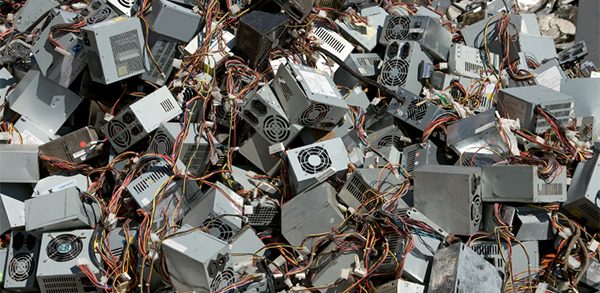
Of all the sources of electronics components, e-waste could be the wisest available. When combined with sustainable recycling, could become on of the best sources available for valuable electronics components. In fact the reuse of e-waste means that our growing mass of electronics waste can amount to more than just space occupied at the local landfill.
The 21st Century State of E-waste Reuse
E-waste is one of the most sustainable resources on the planet, and there’s tons of it available – more and more everyday.
The world produces 45 million tons of e-waste per year. The US alone (the world’s largest e-waste producer) racks up 2.3 billion tons of e-waste on an annual basis. The question is, how can we recoup the value of electronic waste in ways that won’t harm the environment?
Enter e-waste recycling and reuse. Recycling e-waste is a process involving collection dismantling and shredding electronics, but it can also include separating devices into its various (and valuable) sub-parts for profitable reuse. These subparts and materials include familiar items like plastic and glass as well as rare and dwindling natural resources such as gold, silver, platinum, tin, copper and much more.
Sending these components back onto the market for reuse is a largely what the e-waste recycling process is all about. More importantly, it lends value to the practice of e-waste recycling at a time when some question its validity due to a traditionally low cost-benefits analysis.
Reuse addresses a number of electronics issues including the fact that consumer behavior is currently trending towards reduced electronics lifespans since users are discarding them earlier and earlier after first sale. Reuse also has “ancillary” benefits, says the United Nations University. These include creating jobs, and creating a source of spare parts in industries where originals are extremely costly.
And there’s plenty of incentive for companies to venture into the world of reuse. According to a report written by Transparency Market Research (TMR), “E-Waste Recycling And Reuse Services Market – Global And China Scenario, Trends, Industry Analysis, Size, Share And Forecast 2010 – 2017”, the global e-waste recycling and reuse service market could reach a lofty valuation of over $41 billion by 2019.
5 Ways To Transform E-waste into New(ish) Electronics
That said, here are 5 effective ways e-waste can be transformed into new electronics through reuse, thus decreasing everyone’s electronic waste footprint.
Buy green electronics
The green electronics industry has blossomed since its inception, and the market is still making an effort to stay on the minds of consumers and businesses looking to decrease their e-waste footprint.
Consumer purchases of green electronics can help drive the reuse market – a key to keeping the electronics recycling industry cost-effective. As more and more information proliferates concerning the valuable economic and environmental benefits of buying green electronics, so, too, the demand for green electronics could grow in coming years – an ideal situation for the e-waste recycling industry.
Identify key recyclers
As the economic incentives for reuse increase, recyclers are expanding the traditional process of shredding and melting e-waste one step further. More and more recyclers are breaking electronics down to its valuable subparts as part of the e-waste recycling process. If you’re looking to ensure your e-waste goes to good use, it’s key to identify recyclers who carefully separate e-waste components that could be useful in other markets or reused by manufacturers looking to cut costs.
Donate
Donating your electronics waste could expand its lifecycle. One of the major issues in e-waste is the dwindling electronic life cycle. Consumers, reaching for ever newer devices too soon after first purchase, tend to toss their old devices thus adding to the growing electronic waste stream. Such consumer habits increase the proliferation of electronics and the need for organizations willing to accept donations for later reuse.
While some view the ubiquity of electronics as one of the major perils of the e-waste crisis, that’s not the only take on the matter. From a reuse perspective, the soaring amount of e-waste is a definite plus, creating a constant supply source for the manufacture and recycling of new electronics.
Sell reused electronics
Entrepreneurs can take advantage of the reuse market by selling recycled electronics. It’s a practice that’s popping up across the country in the form of locally run “re-stores”. Non profits are also getting in on the benefits of the reuse market with organizations that take in, repair and resell electronics from from recycled or gently used components.
Build green electronics
Manufacturers can benefit from the drive toward transformed e-waste by building green electronics from recycled components. Dell became the first electronics manufacturer to mass produce computers made of recycled materials in 2014. Similar reuse initiatives can be seen throughout the electronics industry.
This type of closed loop process in electronics manufacturing has sizable benefits. According to research conducted under the leadership of the Green Electronics Council, those benefits could total $12 billion if electronics recycling rates reach 100 percent. The benefits include both financial and environmental benefits, such as reducing our reliance on costly mineral mining processes.
Even at current recycling rates, reuse can save $14.6 million in “natural capital” by providing gold, silver and platinum for new electronics, according to Green Electronics Council research.
Transforming E-waste
Clearly the combination of electronics recycling and reuse is a valuable and viable resource. If you or your company have ever ventured into any of the practices mentioned here, you’re already on the right track.
It’s important for consumers and businesses alike to see the connections involved in the electronics manufacturing, use and reuse process. Sustainable recycling is a key component in that process. The ability to recognize the inherent value of most electronics is a huge step toward a world where e-waste ceases to be a threat to sustainability and more of a necessary and effective benefit to society at large.